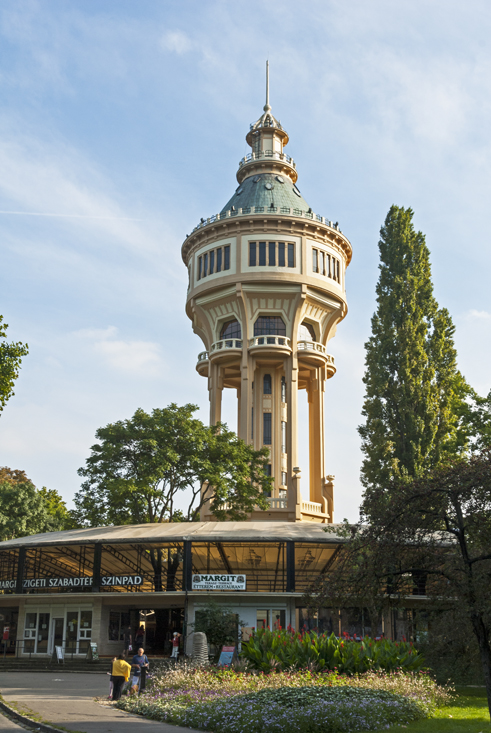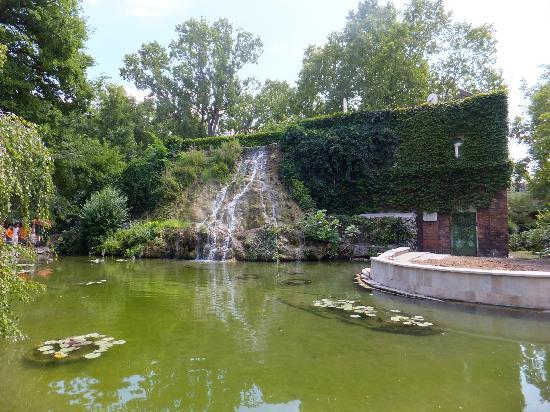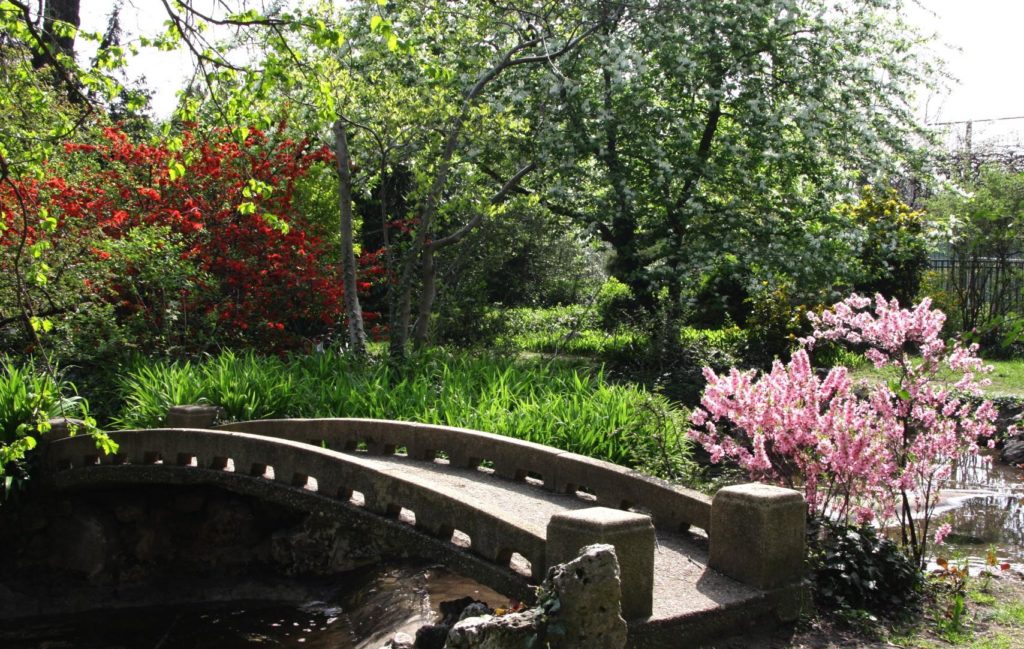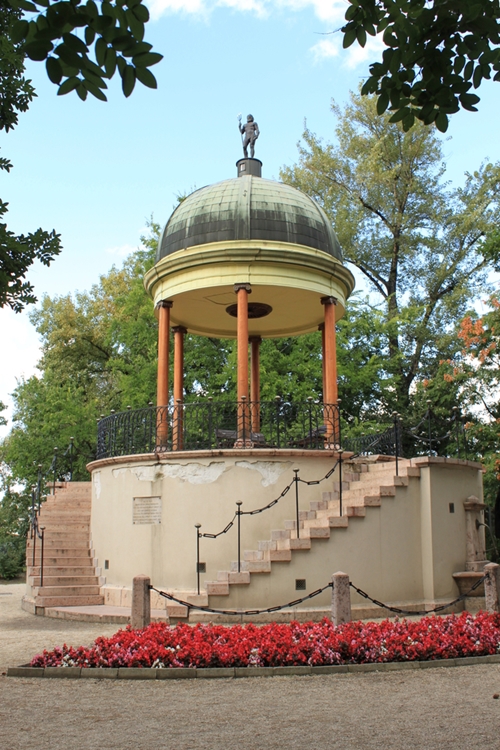More on Margaret Island
Although we generally stayed on the central path, we did make a point of straying a bit toward the east to walk past the Water Tower. This octagonal Art Nouveau structure designed by Rezső Vilmos Ray, who wanted a structure that was both functional and decorative, was built in 1911 and was the first building in Hungary to use reinforced concrete. It’s 57 meters high with a capacity of 600,000 liters and supplies water to the island’s inhabitants and to visitors to the Danubius Grand Hotel Margitszegit – built in 1873.
The tower, which is a protected UNESCO site, opened to the public in 2012 and serves as a venue for art and photography exhibitions. It’s also spot for gaining panoramic views of Budapest for those willing to climb to the cupola on top something we felt we lacked the time (and perhaps the stamina) to do.
There’s also an amphitheater behind the Water Tower.
Our next stop was the Japanese Garden. I couldn’t find any reliable information to reveal why there’s a Japanese Garden on an island in the Danube between the cities of Buda and Pest but I was certainly curious to see it. What I did learn was that the garden was created in the 1970s and fell into disrepair as communism waned. However, it underwent significant renovations sometime around 2013. Some of the plants that died have been replaced by new species. Some of the fountains have been made to appear natural.
Small arched bridges
together with long red-and-black metal benches inspired by and intended to add a sense of Japanese culture can be found throughout this small 10,500 square meter spot of serenity. I have to admit being puzzled by some of the statuary found in the ponds that dot the garden. They seemed inharmonious with the attempt to create a sense of Japanese culture. This is the prime example:
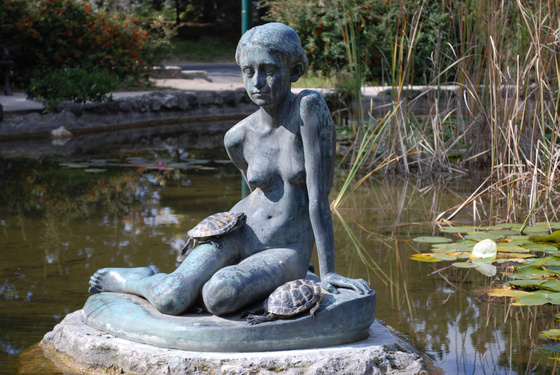 Of course, the turtles make it all worthwhile.
Of course, the turtles make it all worthwhile.
Our final stop before, like the Mongols eight centuries earlier, turning in the direction whence we came was just a few steps north of the Japanese Garden. It’s another musical fountain colloquially called the Bodor kút or officially the zenélő kút which translates as musical fountain or musical well. (The large one at the southern end is correctly called Zenélő szökőkút or leaping musical fountain.) The Margit-sziget zenélő kút is, in fact, a copy of one built in 1820 by a Transylvanian handyman, Péter Bodor, for the area of Marosvásárhely (now in Budapest’s District 18). The copy was built in 1936.
This is a fountain in the sense of being a drinking fountain and you can see one of the three taps on the right side in the photo. The Neptune statue on the top reflects the time and completes one rotation every 24 hours. According to an article I read, the fountain plays medieval inspired Hungarian melodies on the hour. As with the other musical fountain, our timing didn’t match that schedule so Patricia and I didn’t hear any tunes emanating from it.
Having covered more than two kilometers of the island’s 2.5-kilometer length, we knew it was time to turn back because we also had to stay on schedule to meet Alison. Little did we suspect at the time that we were about to become fugitives.
Streetcar scofflaws
In previous posts about Hungary, I mentioned that our local guide gave us a brief orientation to Budapest’s public transportation system and noted that she’d purchased a group ticket as we rode around the city.
Public transportation in Budapest is a blended system of buses, trams, trolleys, and metro trains. (There are also boats, a funicular and a chairlift but I’m ignoring those.) It’s extensive, inexpensive and, within my limited experience, quite reliable. Paying for it on the other hand, well, I’ll let this explanation from the website Budapestbylocals speak for itself:
- Single ticket (vonaljegy or just jegy) 350 HUF, (450 HUF if purchased from the driver on board the vehicle): valid on all public transport vehicles for one uninterrupted trip.
- Single transfer ticket (átszállójegy): 530 HUF
- Metro Section Ticket (for up to 3 stops): 300 HUF: valid for one uninterrupted trip without change on all 3 metro lines for 3 stops for 30 minutes. It does not entitle you for interruption of the trip or for return trip. Within its validity you can change lines within the metro network, but it is valid only for 3 stops altogether (i.e. 3, 2+1 or 1+2 stations).
- 24-hour travel card (napijegy: 1 650 HUF): valid on all public transport vehicles, incl. D14 boat service, on boat services D11, D12 and D13 only on workdays for an unlimited number of trips from 0:00 to 24:00 of the day indicated on the ticket (you decide on the starting time).
- 24-hour group travel card, for max. 5 persons: 3 300 HUF,: valid on all public transport vehicles, incl. D14 boat service, on boat services, , on boat services D11, D12 and D13 only on workdays for an unlimited number of trips from 0:00 to 24:00 of the day indicated on the ticket (you decide on the starting time).
- 72-hour travel card (turistajegy: 4 150 HUF): valid on all public transport vehicles for an unlimited number of trips for 72 hours starting from the time and date you purchased it.
- 7-day travel-card (hetijegy: 4 950 HUF): vaild on all public transport vehicles from 0:00 to 24:00 till the sixth day following purchase of the card for an unlimited number of trips.
Oh, and I didn’t copy the bit that says that EU citizens aged 65 and older ride for free. HUF is the abbreviation for Hungarian forint. Today, one US dollar buys about 300 forints (The rate was closer to 270 when I was there in August.) so a single one-way ticket costs about $1.25 and a five-person 24-hour group card is about $11.00. But the unspoken truth is, it all runs on the honor system.
In our time there, we rode buses, Metro, and a tram. Each of these has a mechanical reader that, after you’ve boarded, validates the ticket you’ve purchased before boarding. On any of these transports, a conductor can ask to see your validated ticket.
By the time Pat and I crossed Margaret Bridge back into Pest, we’d probably walked between eight and ten kilometers and were a bit tired. Fortunately for us, one terminus of the Number 2 tram line (about which I’ll have more to write in a moment) is at Jászai Mari tér which is just steps from the bridge. Unfortunately for us, we could find no place to buy a ticket and, since it was our last day, neither of us had much cash in case we had to buy one on the tram.
However, in our previous bus, tram, and metro rides, we’d never seen a conductor let alone one that asked to see a validated ticket. So, we hopped on the waiting and unoccupied tram hoping our good fortune would continue or anticipating playing the ugly/stupid American tourist card if it didn’t. We’d only need to survive three stops to Széchenyi István tér (Stephen Széchenyi Square) before we could hop off and walk a bit less than a kilometer to the hotel. And we made it. So, both of us left the country as streetcar scofflaws each owing the Budapest transit system about $1.30.
Coming up, a ride on Budapest’s famous Number 2 tram and our reunion with Alison.
